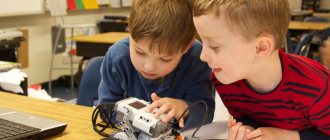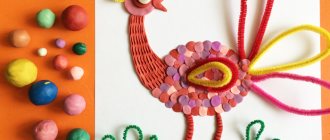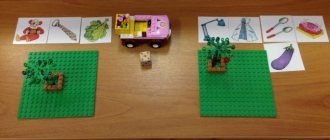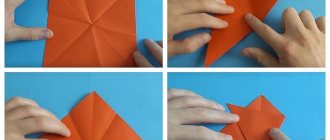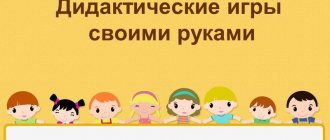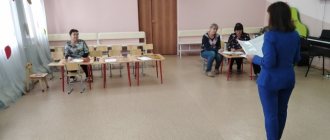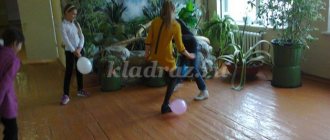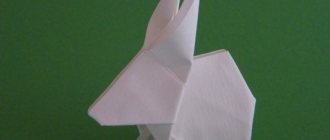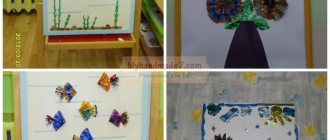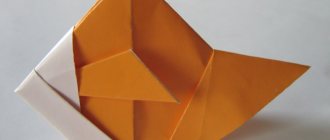Presentation "Construction in kindergarten" presentation for a lesson on the topic
Slide 1
Prepared by: senior teacher of State Budget Educational Institution Secondary School No. 1317, Moscow Olga Ivanovna Sviridenko Construction in kindergarten
Slide 2
The term “construction” (from the Latin construo build, create) means creating a model, constructing, putting into a certain order and the relationship of various objects, parts, elements. Construction is a productive activity, since it is aimed at obtaining a specific product, both real-life objects and objects invented by the children themselves. Children's design is usually understood as the creation of various buildings from building materials, the production of crafts and toys from paper, cardboard, wood and other materials.
Slide 3
Types of design There are two types of design: technical and artistic. In technical design, children display real-life objects, and also come up with crafts by association with images from fairy tales and films. The technical type of design activity includes: design from building materials; construction from designer parts with different fastening methods; construction from large-sized modular blocks. In artistic design, children, when creating images, not only display their structure, but also express their attitude towards them, convey their character, using color and shape. The artistic type of design includes design from paper and design from natural material.
Slide 4
Material for construction Construction from building materials. The main material for construction, from which a child’s acquaintance with this type of activity begins, is a construction set. As a rule, this is a wooden or plastic construction kit consisting of various geometric shapes (plates, cubes, prisms, cylinders of different sizes and colors).
Slide 5
Construction from paper and additional materials. This type of construction is taught to children in middle, high school and pre-school groups. It is not easy to build a three-dimensional toy from flat material (paper and cardboard), since both paper and cardboard are prepared in the form of squares, rectangles, circles, and triangles. All this is much more complicated than constructing buildings from individual ready-made forms by composing them.
Slide 6
Construction from natural materials. Starting from the middle group, chestnut fruits, pine cones, spruce cones, alder shells, bark, branches, straw, acorns, maple seeds, etc. are used for construction. The peculiarity of making toys from natural material is that its natural shape is used. This type of design is closest to fine art.
Slide 7
Forms of organizing teaching children's design Design based on a model The first and most elementary type of design. The adult invites the child to place the cubes the way they are, in the same sequence (color and shape). Such activities require the child’s attention, concentration and the ability to “act according to a model.”
Slide 8
Construction according to conditions In this case, the child begins to build his construction not on the basis of a model, but on the basis of conditions that are put forward by the tasks of the game or by adults.
Slide 9
Design using simple drawings and visual diagrams This is a type of design in which the external and individual functional features of real objects are recreated from parts of building material.
Slide 10
Design according to plan Here nothing limits the imagination of the child and the building material itself. This type of construction is usually required by the game. Children strive to make a building so that it corresponds to the concept of the game.
Slide 11
The main tasks of pedagogical work with children on construction 1st junior group In games with tabletop and floor building materials, continue to acquaint children with the details (cube, brick, triangular prism, plate, cylinder), with options for the arrangement of building forms on the plane. Continue to teach children how to build elementary buildings based on the model and support the desire to build something on their own. Promote the development of spatial relationships. Learn to use additional story toys commensurate with the scale of the buildings (small cars for small garages, etc.). Introduce children to the simplest plastic construction sets. Together with an adult, design turrets, houses, cars.
Slide 12
2nd junior group Lead children to a simple analysis of the created buildings. Improve constructive skills. Strengthen the ability to distinguish, name and use basic building parts (cubes, bricks, triangular prisms, plates, cylinders), construct new buildings using previously acquired skills (laying, attaching, applying). Learn to place bricks and plates vertically, place them close to each other, at a certain distance. Change buildings in two ways: replacing some parts with others or building them up in height and length. Develop a desire to build buildings according to your own plans; continue to teach children how to play around with buildings. Instill a feeling of joy at a successful construction.
Slide 13
Middle group Continue to develop in children the ability to distinguish and name building parts (cube, plate, brick, block), teach them to use them taking into account their structural properties (stability, shape, size). Develop the ability to establish associative connections by asking them to remember what similar structures children have seen. Develop the ability to analyze a building sample: identify the main parts and distinguish and correlate them by size and shape, establish the spatial arrangement of these parts relative to each other (in houses - walls, at the top - ceiling, roof; in a car - cabin, body, etc. ). Develop the ability to independently measure buildings (in height, length and width), to follow the design principle set by the teacher (“Build the same house, but tall”). Learn to build buildings from large and small building materials, use parts of different colors. Teach paper construction: bend a rectangular sheet of paper in half, matching the sides and corners (album, flags for decorating a site, greeting card), glue parts to the main shape (to a house - windows, doors, pipe; to a bus - wheels; to a chair - back). Involve children in making crafts from natural materials: bark, branches, leaves, cones, chestnuts, nut shells, straw (boats, hedgehogs, etc.). Use glue or plasticine to secure the parts. Use spools, boxes of different sizes and other items in crafts.
Slide 14
Senior group Continue to develop the ability to establish connections between the buildings being created and the objects of the surrounding world. Strengthen the ability to identify the main parts and characteristic details of structures. Introduce new parts: plates, bars, cylinders, and cones of various shapes and sizes. Strengthen the ability to replace some parts with others. To develop the ability to create buildings of different sizes and designs of the same object. Strengthen the ability to build according to a drawing, independently select the necessary building material. Continue to develop the ability to work collectively, combine your crafts in accordance with a common plan, agree on who will do what part of the work; help each other when necessary.
Slide 15
Preparatory group for school To develop interest in a variety of buildings and structures (residential buildings, theaters, palaces, farms and others). Encourage the desire to convey their characteristics in constructive activities. Learn to see the design of an object and analyze its main parts, establish the functional purpose of each of them, determine the correspondence of the shapes, sizes, and locations of these parts to the conditions in which the structure will be used. Teach children, based on analysis of structures and objects, to independently find individual constructive solutions. Strengthen teamwork skills - the ability to distribute responsibilities, plan the process of making an item, work in accordance with the general plan, without interfering with each other. Teach children to build different structures of the same object in accordance with different conditions of their use (bridge for pedestrians, bridge for transport), determine which parts are most suitable for construction, how best to combine them, continue to develop the ability to plan the process of constructing a building. Continue to teach how to construct buildings united by one content (street, cars, houses). Introduce a variety of plastic construction sets. Learn to create various models (buildings, planes, trains, etc.) according to a drawing, according to the teacher’s verbal instructions, according to your own ideas.
Slide 16
The importance of design in the development of a preschooler Design is given a significant place in work with children of all age groups, since it has extremely broad opportunities for mental, moral, aesthetic, and labor education. Construction classes develop children's sensory and thinking abilities. It is important that children’s thinking in the process of constructive activity has a practical orientation and is of a creative nature. When teaching children to design, planning mental activity develops, which is an important factor in the formation of educational activity.
Slide 17
List of recommended literature: From birth to school. Basic general education program for preschool education / Ed. NOT. Veraksy, T.S. Komarova, M.A. Vasilyeva. Construction in early age groups, L.V. Kutsakova Lessons in designing from building materials /middle, senior, preparatory groups/, L.V. Kutsakova Design classes for children 3-7 years old, O.Yu. Startseva Forest crafts. ABC of design, I.A. Lykova
My university
Author of the webinar: Raeva Valentina Vyacheslavovna, methodologist of the preschool education support department
Duration: 55 minutes
Who is the webinar for: teachers of preschool educational institutions
Cost of participation in the webinar: free
Cost of a certificate of participation in the webinar: 189 rubles
During the webinar on the topic “Technical design - a type of children’s design”
Preschool teachers have the opportunity to clarify, systematize and generalize the range of issues and tasks on the topic under consideration:
- construction - as a specific children's activity, its features,
- types of design that are possible and desirable for children to master in kindergarten and in the family,
— specifics of technical design for preschool children;
— forms of organizing training for preschool children in technical design.
The author proposes to consider the features of the development of children's technical design, which from the reproductive level “Do as I do!” - “Do it with me!” rises to the level of creativity and solving unique special problems to the ability and ability of the child to independently analyze the building and create it according to his own plan.
Issues covered in the webinar:
| № | Questions | content |
| 1. | construction - a specific children's activity, its features | Construction is a rather complex activity for children. Children's design is usually understood as the creation of various structures and models from building materials, construction kit parts, and the production of crafts from paper, cardboard, and various natural and waste materials. Thanks to this activity, the child’s skills, mental and aesthetic development quickly improve. |
| 2 | types of design | There are two types of design - artistic design and technical design. This is due to the fact that in design there are two interrelated stages: the creation of a plan and the implementation of a plan. The Federal State Educational Standard for preschool education reflects these two vectors of design as a universal activity: In cognitive development, the emphasis is on the development of analytical-synthetic activity in children (a whole consisting of parts; parts combined into a whole); in artistic and aesthetic development, the emphasis is on the development in children of an understanding of the usefulness and beauty of a building (i.e., what represents this building and its place in space)! |
| 3 | specifics of technical design for preschool children | The type of material used in children's constructive activities determines the type of construction. The technical type of design includes: - construction from building material (wooden painted or unpainted parts of geometric shape); -constructing constructors from parts that have different methods of fastening; -construction from large-sized modular blocks; - design based on computer programs. |
| 4 | forms of organizing training for preschool children in technical design. | The following forms of organizing design training for preschoolers are distinguished: 1) design according to a sample; 2) design according to conditions; 3) design by design. |
Educational and methodological materials accompanying the webinar:
We are glad to see you at our webinar!
